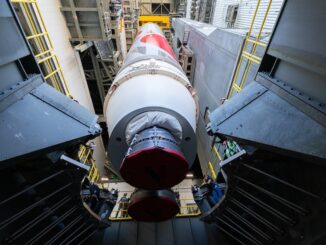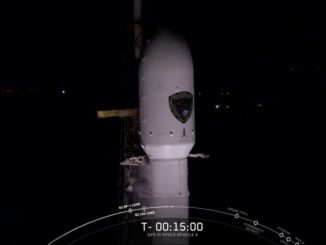
Boeing officials said Monday the company’s Starliner crew capsule will fly a second time without astronauts after software problems and other issues plagued a first test flight in December, preventing the ship from reaching the International Space Station.
The CST-100 Starliner crew capsule was expected to fly with astronauts for the first time this year, capping a multibillion-dollar NASA-funded development program. But a mission timing error caused the spacecraft to burn too much fuel to enter orbit after an otherwise successful launch Dec. 20 prevented the capsule from docking with the space station.
A potentially catastrophic programming oversight discovered after the Starliner’s launch had to be corrected with a software patch to ensure the capsule could safely come back to Earth.
The Starliner capsule, designed to be reusable, landed at White Sands Space Harbor in New Mexico on Dec. 22.
Beleaguered by back-to-back crashes and the subsequent global grounding of the 737 MAX passenger jet and more recent headwinds from the slump in air travel due to the coronavirus pandemic, Boeing said it would fund the unplanned crew capsule test flight “at no cost to the taxpayer.”
Boeing told investors earlier this year it was taking a $410 million charge against its earnings to cover the expected costs of a second unpiloted test flight.
The company on Monday confirmed a report in the Washington Post that it will fly a second uncrewed demonstration mission — which Boeing calls an Orbital Flight Test — before astronauts ride a Starliner into orbit.
“We have chosen to refly our Orbital Flight Test to demonstrate the quality of the Starliner system,” Boeing said in a statement Monay. “Flying another uncrewed flight will allow us to complete all flight test objectives and evaluate the performance of the second Starliner vehicle at no cost to the taxpayer. We will then proceed to the tremendous responsibility and privilege of flying astronauts to the International Space Station.”
NASA said it accepted a recommendation from Boeing to fly a second unpiloted mission.
“Boeing has decided to fly a second uncrewed flight test as a part of NASA’s Commercial Crew Program,” the space agency said in a statement. “Although no new launch date has been set, NASA has accepted the proposal to fly the mission again and will work side-by-side with Boeing to resume flight tests to the International Space Station on the company’s CST-100 Starliner system.”
The Washington Post reported the second Orbital Flight Test, with much the same objectives as the first, is expected to launch from Cape Canaveral “sometime in October or November.”
Boeing said the company is “committed to the safety of the men and women who design, build and ultimately will fly on the Starliner just as we have on every crewed mission to space.”
“Although many of the objectives of Boeing’s first uncrewed flight test in December 2019 were accomplished, Boeing decided the best approach to meeting the agency’s requirements would be to fly the mission again, including docking with the space station,” NASA said Monday. “Data from the next and previous flight test will be used as part of NASA’s process of certifying Boeing’s crew transportation system for carrying astronauts to and from the space station.”
Earlier this year, Boeing officials said the company missed chances to uncover the software bugs during testing before the first Orbital Flight Test.
John Mulholland, vice president and manager of Boeing’s CST-100 Starliner program, said in February that the company performed testing of Starliner’s software in chunks, with each test focused on a specific segment of the mission. Boeing did not perform an end-to-end test of the entire software suite, and in some cases used stand-ins, or emulators, for flight computers.
A review team investigating the miscues during the December test flight issued some 60 recommendations to be implemented before the Starliner flies in space again. Doug Loverro, head of NASA’s human spaceflight directorate, said last month he designated the botched Starliner test flight a “high-visibility close call,” which triggers another government review.

One of the software problems was immediately apparent after the Starliner’s ascent into space Dec. 20 from Cape Canaveral aboard a United Launch Alliance Atlas 5 rocket. A mission elapsed timer on the capsule had a wrong setting, causing the spacecraft to miss a planned engine firing soon after separating from the Atlas 5’s Centaur upper stage.
The orbit insertion burn was required to inject the Starliner capsule into a stable orbit and begin its pursuit of the space station. After the automated sequence failed due to the on-board timer setting, ground controllers at NASA’s Johnson Space Center in Houston had to uplink manual commands for the Starliner spacecraft to perform the orbit insertion burn, but the ship burned too much fuel during the process, leaving insufficient propellant to rendezvous and dock with the space station.
Ground teams in Houston also encountered trouble establishing a stable communications link with the Starliner when they attempted to send commands for the orbit insertion burn, further delaying the start of the maneuver. Boeing says ground teams had issues connecting with the spacecraft on more than 30 additional occasions during the Starliner’s two-day test flight.
With a docking to the space station no longer possible, mission managers cut short the Starliner test flight and targeted landing in New Mexico on Dec. 22.
After the mission timer problem, Boeing engineers reviewed other segments of the Starliner’s software code to search for other problem areas. They uncovered another software error that was missed in pre-flight testing, which could have caused the Starliner’s service module to slam into the craft’s crew module after the ship’s two elements separated just before re-entry into the atmosphere.
A software fix uplinked to the Starliner spacecraft before re-entry ensured the capsule could safely land.
“The second uncrewed flight does not relieve Boeing from completing all the actions determined from the joint NASA/Boeing independent review team, which was commissioned following the flawed initial flight,” NASA said in a statement. “NASA still intends to conduct the needed oversight to make sure those corrective actions are taken.”
Boeing has two space-rated Starliner crew capsules in preparation at the Kennedy Space Center in Florida, including the craft that flew in December. Both are designed to fly up to 10 times to the space station, with each mission lasting up to seven months.
Boeing astronaut Chris Ferguson — a former space shuttle commander — is assigned to the first crewed Starliner test flight. NASA astronauts Mike Fincke and Nicole Mann will also be aboard the Starliner’s Crew Flight Test, a prerequisite to operational crew rotation missions using the Boeing capsule.
Space agency officials said Monday they have not determined a schedule for the first crewed Starliner mission.
NASA is paying Boeing more than $4.8 billion to design, develop, test and fly astronauts on the the Starliner spacecraft to the space station. Boeing announced the CST-100 Starliner program in 2010, and officials at the time said the capsule could begin operational crew rotation flights to the station by 2015.
That schedule fell aside after NASA encountered difficulty securing funding from Congress for the commercial crew program, which aims to restore U.S. human spaceflight capability and end NASA’s reliance on Russian Soyuz crew ships to get astronauts to the space station.
Once funded, the program suffered a series of delays caused by technical problems with the Starliner and SpaceX’s Crew Dragon spaceship, NASA’s other commercial crew program.
NASA has agreements with SpaceX valued at $3.1 billion to develop and fly the Crew Dragon spaceship.
The Crew Dragon has successfully completed all of its test flights before astronauts strap in and ride the capsule into orbit. The SpaceX capsule successfully docked with the space station and returned to Earth on an uncrewed mission in March 2019, but an explosion during a ground test of the ship’s launch escape engines in April 2019 forced a multi-month delay.
SpaceX redesigned part of the high-pressure abort propulsion system, and demonstrated the change during an in-flight escape test in January over the Kennedy Space Center in Florida.
NASA astronauts Doug Hurley and Bob Behnken could take off from the Kennedy Space Center on the Crew Dragon’s final test flight — the first one with a crew on-board — as soon as mid-to-late May atop a SpaceX Falcon 9 rocket on a trip to the International Space Station, according to the space agency. Another Crew Dragon mission with four astronauts could launch to the space station later in the summer.
It will be the first crewed launch into Earth orbit from U.S. soil since the retirement of the space shuttle in 2011.
“This is exactly why NASA decided to select two partners in the commercial crew effort,” NASA said Monday. “Having dissimilar redundancy is key in NASA’s approach to maintaining a crew and cargo aboard the space station and to keeping our commitments to international partners. It also allows our private industry partners to focus on crew safety rather than schedule. The safety of our commercial crew team always will remain as our top priority.”
United Launch Alliance, a 50-50 joint venture between Boeing and Lockheed Martin, is the launch provider for the Starliner program.

“We are ready to support Boeing and NASA when they are ready to fly the second Orbital Flight Test,” ULA said in a statement Monday. “We continue to work closely with Boeing to ensure that the CST-100 Starliner flies as soon as the spacecraft is ready. We are committed to safety and mission assurance and are working to ensure the highest level of safety for the future crew.”
The Atlas 5 rocket for Starliner’s first piloted mission — called the Crew Flight Test — is already at Cape Canaveral after delivery from ULA’s factory in Alabama last year. That launch vehicle is expected to be used for the second Orbital Flight Test.
“The hardware for the next flight is at the Cape and is ready for launch processing once a launch date has been determined by the Boeing, NASA and ULA team,” ULA said in a statement.
Email the author.
Follow Stephen Clark on Twitter: @StephenClark1.



